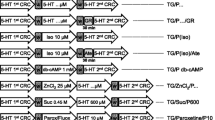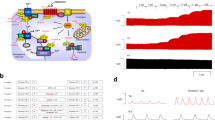Abstract
We studied the mRNA expression and function of 5-hydroxytryptamine (5-HT) receptors as well as their signal transduction in right atrial tissue from patients undergoing cardiac surgery and right ventricular tissue from human donor hearts. In isolated, electrically driven strips from human right atrium, 5-HT exerted concentration-dependent positive inotropic effects (EC50 value = 0.10 ± 0.01 μM) and hastened relaxation (positive lusitropic effect). The 5-HT4 receptor antagonists SB203186 or GR125487 antagonised these effects. 5-HT (2 μM) increased the content of cyclic adenosine monophosphate (cAMP) from 6.86 ± 1.36 to 19.1 ± 2.45 pmol/mg protein (n = 6, p < 0.05) but did not alter the tissue content of inositol-1,4,5-trisphosphate (IP3). With reverse transcription polymerase chain reaction, mRNAs coding for the 5-HT4 receptor splice variants 5-HT4(a), 5-HT4(b) and 5-HT4(c) were detected in human right atrium and right ventricle. 5-HT2A mRNA only was measurable in human atrium. Expression level of total 5-HT4 receptor mRNA in the right ventricle amounted to 41% (n = 5–8) of that in the right atrium. 5-HT (2 μM) increased the atrial phosphorylation states of phospholamban to 168% at serine-16 and to 150% at threonine-17 (n = 4; p < 0.05) and of the inhibitory subunit of troponin to 150% (n = 6; p < 0.05). In conclusion, the positive inotropic and lusitropic effects of 5-HT in electrically driven human right atria are mediated via 5-HT4 receptors. These effects are accompanied by and probably due to an increase in cAMP content and the subsequent elevation of the phosphorylation state of Ca2+ regulatory proteins.








Similar content being viewed by others
References
Bach T, Syversveen T, Kvingedal AM, Krobert KA, Brattelid T, Kaumann AJ, Levy FO (2001) 5-HT4(a) and 5-HT4(b) receptors have nearly identical pharmacology and are both expressed in human atrium and ventricle. Naunyn Schmiedebergs Arch Pharmacol 363:146–160
Bartel S, Stein B, Eschenhagen T, Mende U, Neumann J, Schmitz W, Krause EG, Karczewski P, Scholz H (1996) Protein phosphorylation in isolated trabeculae from nonfailing and failing human hearts. Mol Cell Biochem 157:171–179
Benfey BG, Cohen J, Kunos G, Vermes-Kunos I (1974) Dissociation of 5-hydroxytryptamine effects on myocardial contractility and cyclic AMP accumulation. Br J Pharmacol 50:581–585
Birkeland JA, Swift F, Tovsrud N, Enger U, Lunde PK, Qvigstad E, Levy FO, Sejersted OM, Sjaastad I (2007) Serotonin increases L-type Ca2+ current and SR Ca2+ content through 5-HT4 receptors in failing rat ventricular cardiomyocytes. Am J Physiol Heart Circ Physiol 293:H2367–2376
Blondel O, Gastineau M, Dahmoune Y, Langlois M, Fischmeister R (1998) Cloning, expression and pharmacology of four human 5-hydroxytryptamine4 receptor isoforms produced by alternative splicing in the carboxyl terminus. J Neurochem 70:2252–2261
Blondel O, Vandecasteele G, Gastineau M, Leclere S, Dahmoune Y, Langlois M, Fischmeister R (1997) Molecular and functional characterization of a 5-HT4 receptor cloned from human atrium. FEBS Lett 412:465–474
Böhm M, Brückner R, Hackbarth I, Haubitz B, Linhart R, Meyer W, Schmidt B, Schmitz W, Scholz H (1984) Adenosine inhibition of catecholamine-induced increase in force of contraction in guinea pig atrial and ventricular heart preparations. Evidence against a cyclic AMP- and cyclic GMP-dependent effect. J Pharmacol Exp Ther 230:483–492
Bodor GS, Oakeley AE, Allen PD, Crimmins DL, Ladenson JH, Anderson PAW (1997) Troponin I phosphorylation in the normal and failing adult human heart. Circulation 96:1495–1500
Boknik P, Neumann J, Schmitz W, Scholz H, Wenzlaff H (1997) Characterization of biochemical effects of CGS 21680C, an A2-adenosine receptor agonist, in the mammalian ventricle. J Cardiovasc Pharmacol 30:750–758
Bradford MM (1976) A rapid and sensitive method for quantitation of microgram quantities of protein utilizing the principle of protein-dye binding. Anal Biochem 72:248–254
Brattelid T, Kvingedal AM, Krobert KA, Andressen KW, Bach T, Hystad ME, Kaumann AJ, Levy FO (2004a) Cloning, pharmacological characterisation and tissue distribution of a novel 5-HT4 receptor splice variant, 5-HT4(i). Naunyn Schmiedebergs Arch Pharmacol 369:616–628
Brattelid T, Qvigstad E, Lynham JA, Molenaar P, Aass H, Geiran O, Skomedal T, Osnes JB, Levy FO, Kaumann AJ (2004b) Functional serotonin 5-HT4 receptors in porcine and human ventricular myocardium with increased 5-HT4 mRNA in heart failure. Naunyn Schmiedebergs Arch Pharmacol 370:157–166
Brattelid T, Qvigstad E, Birkeland JA, Swift F, Bekkevold SV, Krobert KA, Sejersted OM, Skomedal T, Osnes JB, Levy FO, Sjaastad I (2007) Serotonin responsiveness through 5-HT(2A) and 5-HT(4) receptors is differentially regulated in hypertrophic and failing rat cardiac ventricle. J Mol Cell Cardiol 43:767–779
Brodde OE, Zerkowski HR, Schranz D, Broede-Sitz A, Michel-Reher M, Schäfer-Beisenbusch E, Piotrowski JA, Oelert H (1995) Age-dependent changes in the beta-adrenoceptor-G-protein(s)-adenylyl cyclase system in human right atrium. J Cardiovasc Pharmacol 26:20–26
Danielsen W, v der Leyen H, Meyer W, Neumann J, Schmitz W, Scholz H, Starbatty J, Stein B, Doring V, Kalmar P (1989) Basal and isoprenaline-stimulated cAMP content in failing versus nonfailing human cardiac preparations. J Cardiovasc Pharmacol 14:171–173
Docherty JR (1988) Investigations of cardiovascular 5-hydroxytryptamine receptor subtypes in the rat. Naunyn Schmiedeberg’s Arch Pharmacol 337:1–8
Foguet M, Hoyer D, Pardo LA, Parekh A, Kluxen FW, Kalkman HO, Stühmer W, Lübbert H (1992) Cloning and functional characterization of the rat stomach fundus receptor. EMBO J 11:3481–3487
Gale JD, Grossmann CJ, Darton J, Bunce KT, Whitehead JWF, Knight J, Parkhouse TJ, Oxford AW (1994) A selective and high affinity 5-HT4 receptor antagonist. Br J Pharmacol 113:120P
Gerald C, Adham N, Kao HT, Ohlsen MA, Laz TM, Schechter LE, Bard JA, Vaysse PJ, Hartig PR, Branchek TA, Weinshank RL (1995) The 5-HT4 receptor: molecular cloning and pharmacological characterization of two splice variants. EMBO J 12:2806–2815
Gergs U, Boknik P, Schmitz W, Simm A, Silber RE, Illes P, Neumann J (2007) ATP modified contraction in the human heart. Naunyn Schmiedebergs Arch Pharmacol 375(Suppl. 1):63 (Abstract)
Guest PC, Salim K, Skynner HA, George SE, Bresnick JN, McAllister G (2000) Identification and characterization of a truncated variant of the 5-hydroxytryptamine(2A) receptor produced by alternative splicing. Brain Res 876:238–244
Hoyer D, Clarke DE, Fozard JR, Hartig PR, Martin GR, Mylecharane EJ, Saxena PR, Humphrey PPA (1994) IUPHAR classification of receptors for 5-hydroxytryptamine (serotonin). Pharmacol Rev 46:157–203
Hoyer D, Hannon JP, Martin GR (2002) Molecular, pharmacological and functional diversity of 5-HT receptors. Pharmacol Biochem Behav 71:533–554
Kaumann AJ (1991) 5-HT4-like receptors in mammalian atria. J Neural Transm 34:195–201
Kaumann AJ (1994) Do human atrial 5-HT4 receptors mediate arrhythmias? TIPS 15:451–455
Kaumann AJ, Birnbaumer L (1974) Prostaglandin E1 action on sinus pacemaker and adenylyl cyclase in kitten myocardium. Nature 251:515–517
Kaumann AJ, Levy FO (2006) 5-hydroxytryptamine receptors in the human cardiovascular system. Pharmacol Ther 111:674–706
Kaumann AJ, Lynham JA, Brown AM (1995) Labelling with [125I]-SB 207710 of a small 5-HT4 receptor population in piglet right atrium: functional relevance. Br J Pharmacol 115:933–936
Kaumann AJ, Lynham JA, Brown AM (1996) Comparison of the densities of 5-HT4 receptors, beta 1- and beta 2-adrenoceptors in human atrium: functional implications. Naunyn Schmiedebergs Arch Pharmacol 353:592–595
Kaumann AJ, Sanders L (1994) 5-Hydroxytryptamine causes rate-dependent arrhythmias through 5-HT4 receptors in human atrium: facilitation by chronic β-adrenoceptor blockade. Naunyn Schmiedeberg’s Arch Pharmacol 349:331–337
Kaumann AJ, Sanders L, Brown AM, Murray KJ, Brown MJ (1990) A 5-hydroxytryptamine receptor in human atrium. Br J Pharmacol 100:879–885
Kaumann AJ, Sanders L, Brown AM, Murray KJ, Brown MJ (1991) A 5-HT4-like receptor in human right atrium. Naunyn Schmiedeberg’s Arch Pharmacol 344:150–159
Läer S, Neumann J, Remmers F, Scholz H (1998a) Comparison of functional coupling and mRNA expression of 5-hydroxytryptamine receptor subtypes in human and rat heart. Naunyn Schmiedebergs Arch Pharmacol 358(Suppl. 1):R632 (Abstract)
Läer S, Remmers F, Scholz H, Ismail M, Neumann J (1998b) Signaltransduction of 5-hydroxytryptamine receptors in human and rat atrium. Z Kardiol 87(Suppl. 1):279 (Abstract)
Läer S, Remmers F, Scholz H, Stein B, Müller FU, Neumann J (1998c) Receptor mechanism involved in the 5-HT-induced inotropic action in the rat isolated atrium. Br J Pharmacol 123:1182–1188
Läer S, Remmers F, Scholz H, Stein B, Uebeler J, Tsilemingas T, Reiter A, Boknik P, Neumann J (1999) Regional expression of 5-HT4 splice variants in the human heart. Naunyn Schmiedebergs Arch Pharmacol 359(Suppl. 3):R105 (Abstract)
Lezoualc’h F, Steplewski K, Sartiani L, Mugelli A, Fischmeister R, Bril A (2007) Quantitative mRNA analysis of serotonin 5-HT4 receptor isoforms, calcium handling proteins and ion channels in human atrial fibrillation. Biochem Biophys Res Commun 357:218–224
Linck B, Boknik P, Eschenhagen T, Müller FU, Neumann J, Nose M, Jones LR, Schmitz W, Scholz H (1996) Messenger RNA expression and immunological quantification of phospholamban and SR-Ca2+-ATPase in failing and nonfailing human hearts. Cardiovasc Res 31:625–632
Lüss H, Meissner A, Rolf N, Van Aken H, Bokník P, Kirchhefer U, Knapp J, Läer S, Linck B, Lüss I, Müller FU, Neumann J, Schmitz W (2000) Biochemical mechanism(s) of stunning in conscious dogs. Am J Physiol Heart Circ Physiol 279:H176–H184
MacLennan DH, Kranias EG (2003) Phospholamban: a crucial regulator of cardiac contractility. Nat Rev Mol Cell Biol 4:566–577
Mayr GW, Thieleczek R (1991) Masses of inositol phosphates in resting and tetanically stimulated vertebrate skeletal muscles. Biochem J 280:631–640
Murphy LD, Herzog CE, Rudick JB, Fojo AT, Bates SE (1990) Use of the polymerase chain reaction in the quantitation of mdr 1 gene expression. Biochemistry 29:10351
Parker SG Taylor EM, Hamburger SA, Vimal M, Kaumann AJ (1995) Blockade of human and porcine myocardial 5-HT4 receptors by SB 203186. Naunyn Schmiedeberg’s Arch Pharmacol 353:28–35
Qvigstad E, Brattelid T, Sjaastad I, Andressen KW, Krobert KA, Birkeland JA, Sejersted OM, Kaumann AJ, Skomedal T, Osnes JB, Levy FO (2005) Appearance of a ventricular 5-HT4 receptor-mediated inotropic response to serotonin in heart failure. Cardiovasc Res 65:869–878
Robiolio PA, Rigolin VH, Wilson JS, Harrison JK, Sanders LL, Bashore TM, Feldman JM (1995) Carcinoid heart disease. Correlation of high serotonin levels with valvular abnormalities detected by cardiac catheterization and echocardiography. Circulation 92:790–795
Simmerman HK, Jones LR (1998) Phospholamban: protein structure, mechanism of action, and role in cardiac function. Physiol Rev 78:921–947
Tramontana M, Giuliani S, Del Bianco E, Lecci A, Maggi CA, Evangelista S, Geppetti P (1993) Effects of capsaicin and 5-HT3 antagonists on 5-hydroxytryptamine-evoked release of calcitonin gene-related peptide in the guinea-pig heart. Br J Pharmacol 108:431–435
Ullmer C, Schmuck K, Kalkman HO, Lübbert H (1995) Expression of serotonin receptor mRNAs in blood vessels. FEBS Lett 370:215–221
Van Nueten JM (1981) Vascular effects of ketanserin (R 41468), a novel antagonist of 5-HT2 serotonergic receptors. J Pharmacol Exp Ther 218:217–230
Verbeuren TJ (1990) The distribution and biochemistry of 5-HT in the cardiovascular system. In: Saxena PR, Wallis DI, Wouters W, Bevan P (eds) Cardiovascular pharmacology of 5-hydroxytryptamine. Kluwer, Dordrecht, pp 3–13
Verbeuren TJ (1992) Distribution, synthesis, metabolism, release, uptake, and passage across body membranes in cardiovascular tissues including blood–brain barrier. In: Olesen J, Saxena PR (eds) 5-Hydroxytryptamine. Raven, New York
Xu J, Jian B, Chu R, Lu Z, Li Q, Dunlop J, Rosenzweig-Lipson S, McGonigle P, Levy RJ, Liang B (2002) Serotonin mechanisms in heart valve disease II: the 5-HT2 receptor and its signaling pathway in aortic valve interstitial cells. Am J Pathol 161:2209–2218
Yusuf S, Al-Saady N, Camm AJ (2003) 5-hydroxytryptamine and atrial fibrillation: how significant is this piece in the puzzle? J Cardiovasc Electrophysiol 14:209–214
Acknowledgements
This study was supported by the Deutsche Forschungsgemeinschaft. We thank Dr. G.S. Bodor (Denver) for the gift of TnI 1E11.3 and 2F6.6.51 antibodies. The work contains parts of the doctoral thesis of Freerk Ole Remmers. The technical assistance of S. Reber is greatly appreciated.
Author information
Authors and Affiliations
Corresponding author
Rights and permissions
About this article
Cite this article
Gergs, U., Neumann, J., Simm, A. et al. Phosphorylation of phospholamban and troponin I through 5-HT4 receptors in the isolated human atrium. Naunyn-Schmied Arch Pharmacol 379, 349–359 (2009). https://doi.org/10.1007/s00210-008-0371-y
Received:
Accepted:
Published:
Issue Date:
DOI: https://doi.org/10.1007/s00210-008-0371-y




